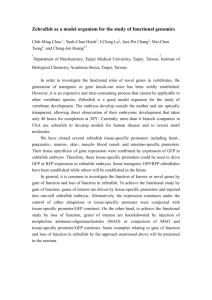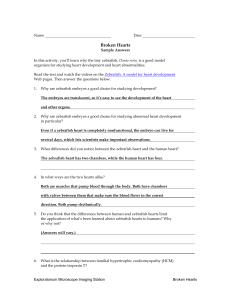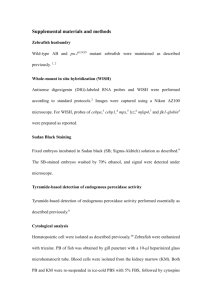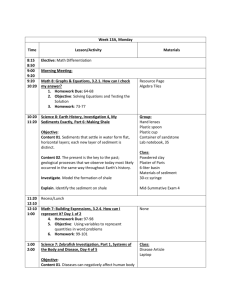Lecture 05
advertisement
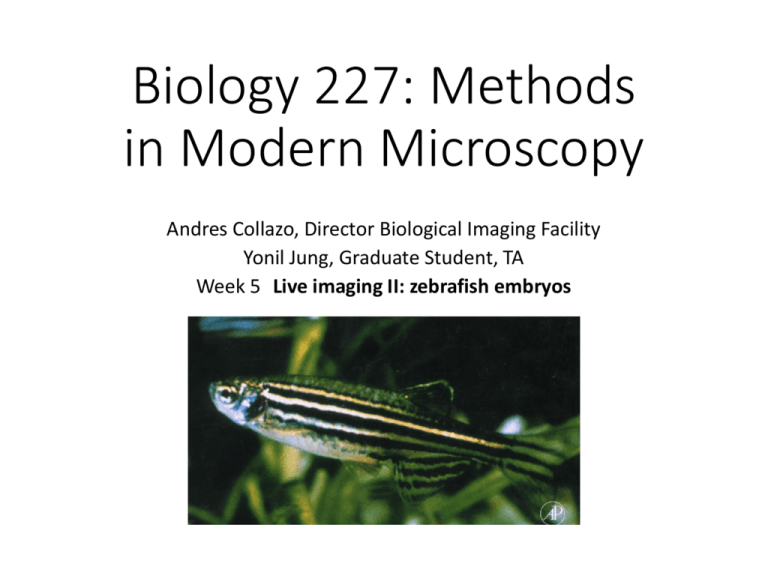
Biology 227: Methods in Modern Microscopy Andres Collazo, Director Biological Imaging Facility Yonil Jung, Graduate Student, TA Week 5 Live imaging II: zebrafish embryos George Streisinger developed zebrafish as a model system From Viruses to Zebrafish A Vertebrate Genetic System Number of Known Vertebrate Species and Taxonomic Distribution (Total 43,173) Teleosts Other Fishes Salamanders Other amphibians Other vertebrates Phylogeny of Deuterostomes Echinoderms Acorn Worms Hemichordates Amphioxus Cephalochordates Ascidians Urochordates Hagfish Myxinoidea Lamprey Petromyzontida Neural Crest & Placodes Shark Chondrichthyes Sturgeon Chondrostei Jawed Vertebrates Gar Ginglymodi Amia Halecomorphi Teleostei Coelacanth Actinistia Lungfish Dipnoi Amniota Amphibia ADVANTAGES OF ZEBRAFISH • Small size • Rapid development • Genetic system • Transparent • Easy to manipulate embryos • All stages accessible DISADVANTAGES OF ZEBRAFISH • Small size • Gene duplication • Not a mammal Zebrafish Chromosomes Amores and Postlethwait 1999 Synteny between Fish and Humans LG9 Hsa2 hoxda HOXD evx2 EVX2 dlx1 DLX1 dlx2 DLX2 Postlethwait et al. 1999. Zebrafish Development Movies from Haffter et al. 1996 ENU (Ethylnitrosourea) Mutagenesis Haffter et al. 1996 ZEBRAFISH ENU MUTAGENESIS Mutagenized males 49 Families raised 3075 Mutants identified 4264 Kept for rescreen 2070 Mutant totals 1163 Total # of genes 372 Genes with 1 allele 222 (60%) Examples of Zebrafish Mutants Zebrafish as a Model of Human Pathologies Transgenic Zebrafish Week 5 Live imaging II: zebrafish embryos • Tissue to be imaged is migratory cell type, the neural crest • Embryos will be available Monday and Wednesday • Treated with PTU to inhibit melanin • Confocal and “wide field” images collected on LSM 410 or 310. • Deconvolution will use Huygens software • Need to create account on Linux computer running the Huygens • Overnight time lapse of migrating neural crest cells Neural crest: A migratory cell type Sox 10 promoter drives GFP in zebrafish neural crest Carney TJ, Dutton KA, Greenhill E, Delfino-Machín M, Dufourcq P, Blader P, Kelsh RN. 2006. A direct role for Sox10 in specification of neural crest-derived sensory neurons. Development 133:4619-4630. Image deconvolution • Inputs: • 3-D image stack • 3-D PSF (bead image) • Requires: • Time • Computer memory • Artifacts? • Algorithms so good now Note: z-axis blurring from the missing cone is minimized but not eliminated Image deconvolution using the Huygens software from SVI • • Point-Spread function (PSF) information is used to calculate light back to its origin Post processing of an image stack using Huygens Top: Macrophage - tubulin, actin & nucleus. Bottom: Imaginal disc – α-tubulin, γ-tubulin. Z-projection of DNA-FISH performed on P2C2 immune cells, BAC probes, three loci (three colors). Say-Tar Goh, Graduate student in the Wold lab. Un-deconvolved Deconvolved Time lapse movies of developing zebrafish: Focus on the inner ear and surrounding tissues α- Catenin Hmga2 Cell Membrane Nuclei Rbms3 Rab3ab Cytoplasm Cytoplasm+Nuclei Other examples of time lapses showing neural crest • Erythrocyte Membrane Protein Band 4.1-like 3b (Epb41l3b) • Time lapse 18+ hours, beginning at ~30 hpf, end at ~2 dpf • Discs large homolog 1-like protein (Dlg1l) • Time-lapse 18 hours, 10 min; Starting at ~28 hpf Week 5 Live imaging II: zebrafish embryos • Tissue to be imaged is migratory cell type, the neural crest • Embryos will be available Monday and Wednesday • Treated with PTU to inhibit melanin • Confocal and “wide field” images collected on LSM 410 or 310. • Deconvolution will use Huygens software • Need to create account on Linux computer running the Huygens • Overnight time lapse of migrating neural crest cells Optical sectioning even when 3D image stack is incomplete • Deconvolution • Confocal microscopy A Top: Macrophage - tubulin, actin & nucleus. Bottom: Imaginal disc – α-tubulin, γ-tubulin. Neural Gata-2 Promoter GFP-Transgenic Zebrafish; with Shuo Lin, UCLA P




